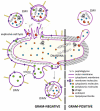Delivery of Toxins and Effectors by Bacterial Membrane Vesicles
- PMID: 34941684
- PMCID: PMC8703475
- DOI: 10.3390/toxins13120845
Delivery of Toxins and Effectors by Bacterial Membrane Vesicles
Abstract
Pathogenic bacteria interact with cells of their host via many factors. The surface components, i.e., adhesins, lipoproteins, LPS and glycoconjugates, are particularly important in the initial stages of colonization. They enable adhesion and multiplication, as well as the formation of biofilms. In contrast, virulence factors such as invasins and toxins act quickly to damage host cells, causing tissue destruction and, consequently, organ dysfunction. These proteins must be exported from the bacterium and delivered to the host cell in order to function effectively. Bacteria have developed a number of one- and two-step secretion systems to transport their proteins to target cells. Recently, several authors have postulated the existence of another transport system (sometimes called "secretion system type zero"), which utilizes extracellular structures, namely membrane vesicles (MVs). This review examines the role of MVs as transporters of virulence factors and the interaction of toxin-containing vesicles and other protein effectors with different human cell types. We focus on the unique ability of vesicles to cross the blood-brain barrier and deliver protein effectors from intestinal or oral bacteria to the central nervous system.
Keywords: bacterial toxins; membrane vesicle; pathogenesis; secretion systems; virulence factors.
Conflict of interest statement
The authors declare no conflict of interest.
Figures

Similar articles
-
Molecular weaponry: diverse effectors delivered by the Type VI secretion system.Cell Microbiol. 2015 Dec;17(12):1742-51. doi: 10.1111/cmi.12532. Epub 2015 Nov 3. Cell Microbiol. 2015. PMID: 26432982 Free PMC article. Review.
-
Coordinated delivery and function of bacterial MARTX toxin effectors.Mol Microbiol. 2018 Jan;107(2):133-141. doi: 10.1111/mmi.13875. Epub 2017 Dec 5. Mol Microbiol. 2018. PMID: 29114985 Free PMC article. Review.
-
Polymorphic toxin systems: Comprehensive characterization of trafficking modes, processing, mechanisms of action, immunity and ecology using comparative genomics.Biol Direct. 2012 Jun 25;7:18. doi: 10.1186/1745-6150-7-18. Biol Direct. 2012. PMID: 22731697 Free PMC article.
-
Bacillus anthracis produces membrane-derived vesicles containing biologically active toxins.Proc Natl Acad Sci U S A. 2010 Nov 2;107(44):19002-7. doi: 10.1073/pnas.1008843107. Epub 2010 Oct 18. Proc Natl Acad Sci U S A. 2010. PMID: 20956325 Free PMC article.
-
Biofilm formation and extracellular microvesicles-The way of foodborne pathogens toward resistance.Electrophoresis. 2020 Oct;41(20):1718-1739. doi: 10.1002/elps.202000106. Electrophoresis. 2020. PMID: 32901923 Review.
Cited by
-
Yersinia entomophaga Tc toxin is released by T10SS-dependent lysis of specialized cell subpopulations.Nat Microbiol. 2024 Feb;9(2):390-404. doi: 10.1038/s41564-023-01571-z. Epub 2024 Jan 18. Nat Microbiol. 2024. PMID: 38238469 Free PMC article.
-
Composition and functions of bacterial membrane vesicles.Nat Rev Microbiol. 2023 Jul;21(7):415-430. doi: 10.1038/s41579-023-00875-5. Epub 2023 Mar 17. Nat Rev Microbiol. 2023. PMID: 36932221 Review.
-
Secreted Metabolites from Pseudomonas, Staphylococcus, and Borrelia Biofilm: Modulation of Immunogenicity by a Nutraceutical Enzyme and Botanical Blend.Microorganisms. 2024 May 15;12(5):991. doi: 10.3390/microorganisms12050991. Microorganisms. 2024. PMID: 38792820 Free PMC article.
-
Unraveling the Multifaceted Roles of Extracellular Vesicles: Insights into Biology, Pharmacology, and Pharmaceutical Applications for Drug Delivery.Int J Mol Sci. 2023 Dec 29;25(1):485. doi: 10.3390/ijms25010485. Int J Mol Sci. 2023. PMID: 38203656 Free PMC article. Review.
-
Extracellular Vesicles of Probiotics: Shedding Light on the Biological Activity and Future Applications.Pharmaceutics. 2023 Feb 4;15(2):522. doi: 10.3390/pharmaceutics15020522. Pharmaceutics. 2023. PMID: 36839844 Free PMC article. Review.
References
Publication types
MeSH terms
Substances
LinkOut - more resources
Full Text Sources
Other Literature Sources

